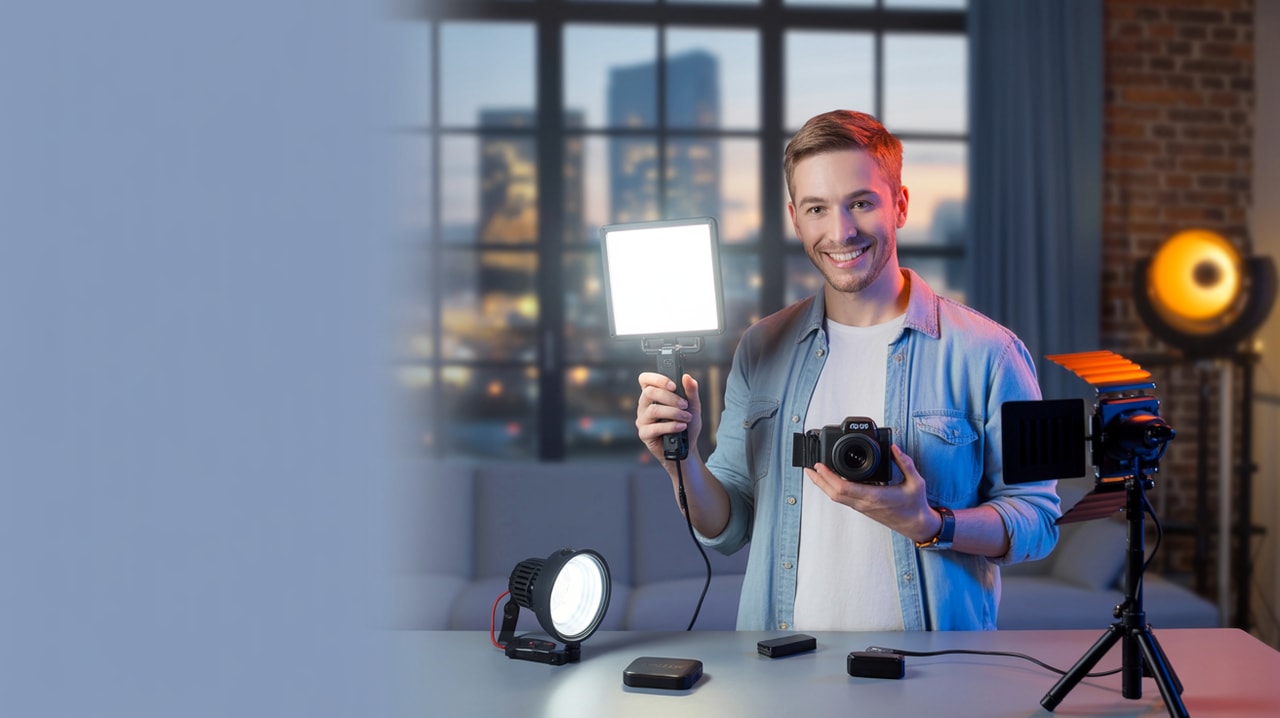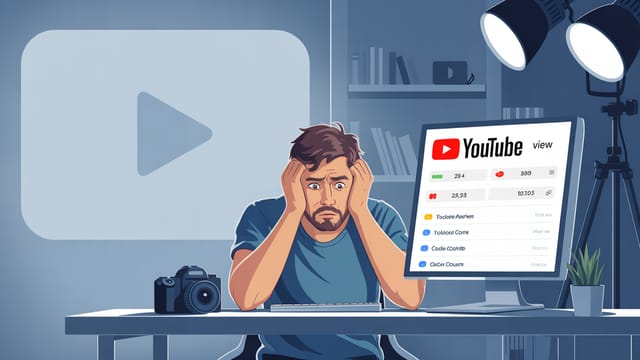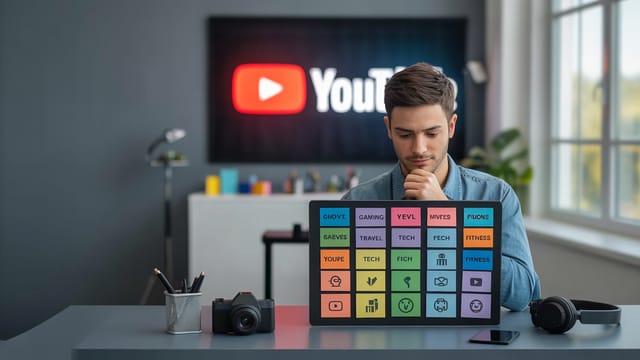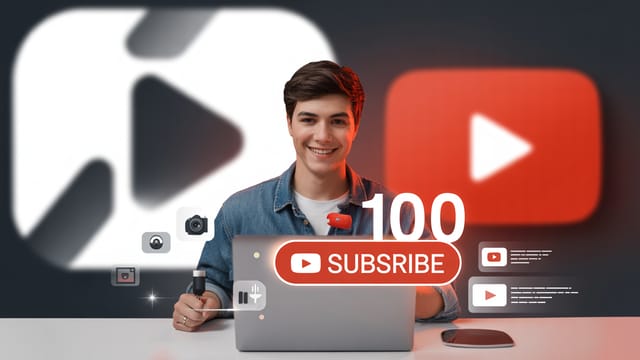
Ready to get your next 10,000 subscribers?
Join thousands of creators who use Subscribr to create faster, better YouTube videos.
Best Portable Lighting for YouTube: Film Anywhere, Look Great
As a YouTube creator, especially if you're a vlogger or film outside a dedicated studio, you know the struggle is real. One day you're basking in perfect natural light, and the next you're battling harsh shadows or dim, inconsistent conditions. This "Travel Vlogger's Dilemma"—the challenge of maintaining high production quality on the go—is a major pain point. Bad lighting can instantly make your video look unprofessional, regardless of how great your content is.
Many creators face equipment limitations and fears, feeling overwhelmed by the technical complexity of lighting. How do you get good lighting when traveling without lugging around bulky, complicated setups? What lights do successful vloggers actually use? And are simple solutions like ring lights good for portable use?
The good news is that achieving great lighting doesn't require a massive studio or a degree in cinematography. The right portable lighting setup can empower you to film high-quality videos anywhere, ensuring consistent visual quality and helping you overcome those equipment fears. This article will guide you through selecting the best portable lighting for your YouTube needs, enhancing your production quality, and making on-location filming simple and effective.
Why Portable Lighting is a Game Changer for Mobile Creators
For vloggers and creators who film away from a fixed setup, portable lighting isn't just a nice-to-have; it's essential. Relying solely on natural light is unpredictable. The time of day, weather conditions, and location all dramatically impact how your video looks. This inconsistency can be jarring for viewers and makes your brand appear less polished.
Portable lights provide control. They allow you to:
- Achieve Consistent Quality: Recreate a similar lighting setup regardless of whether you're indoors, outdoors, during the day, or at night.
- Overcome Difficult Lighting: Fill in shadows, soften harsh sunlight, or brighten dark environments.
- Enhance Production Value: Good lighting makes your subject pop, improves color accuracy, and gives your video a more professional, cinematic feel.
- Film on Your Schedule: You're no longer tied to the "golden hour" or relying on a sunny day. Film whenever inspiration strikes.
Investing in portable lighting directly addresses the pain point of difficulty achieving consistent audio and visual quality on location and helps you overcome equipment limitations and fears by providing a reliable solution.
Key Factors When Choosing Portable Lighting
Selecting the right portable light involves more than just picking the smallest or cheapest option. Consider these factors to find a light that meets your specific needs as a mobile YouTube creator:
- Brightness and Power: Measured in Lux (at a specific distance) or wattage. You need enough power to light your subject effectively in various conditions. A light that's powerful enough can also be dimmed for less demanding situations.
- Color Temperature: This determines the "warmth" or "coolness" of the light, measured in Kelvin (K).
- Bi-color lights allow you to adjust between warm (around 3200K, like indoor tungsten bulbs) and cool (around 5600K, like daylight). This is crucial for matching existing light sources in different locations.
- RGB lights offer the full spectrum of colors, useful for creative effects or matching specific ambient colors, but often come at a higher price. For general portable use, bi-color is usually sufficient.
- Portability: This is key! Look at the size, weight, and build quality. Can it easily fit in your camera bag? Is it durable enough to withstand travel?
- Battery Life: Since you'll be away from power outlets, battery life is critical. Check the type of battery used (often NP-F style or built-in lithium-ion) and the estimated run time at various power levels. Consider carrying spare batteries.
- Diffusion: Hard light creates sharp, unflattering shadows. Soft, diffused light is much more flattering for human subjects. Look for lights that come with built-in diffusion panels or have options to attach softboxes or other modifiers. Larger light sources or diffusers create softer light.
- Ease of Use: How easy is it to set up, adjust settings, and pack down? Addressing the "Technical complexity" pain point means choosing intuitive gear. Look for simple controls, clear displays, and quick setup mechanisms.
Types of Portable Lights for YouTube Creators
Several types of portable lights are popular among vloggers and mobile creators, each with its strengths:
- LED Panels: These are flat panels with multiple small LED lights. They are often compact and lightweight, making them very portable. Many come with built-in diffusion layers or can accept clip-on diffusers. They provide a relatively soft light source, especially for their size.
- Single Point LED Lights: These lights have a single, powerful LED chip. They are often brighter than panels of similar size and power draw. Out of the box, they produce hard light, so they almost always require a softbox or other modifier to soften the light. Many feature a Bowen mount, allowing compatibility with a wide range of professional light modifiers.
- LED Tube Lights: These lights are shaped like tubes and are incredibly versatile. They can be used as backlights, accent lights, or even hidden within the scene for creative effects. They are often battery-powered and can be mounted in various ways or even handheld. While not typically used as the main key light for interviews, they are excellent for adding production value and separating your subject from the background.
- Ring Lights: Ring lights are circular and designed to provide even, frontal lighting, often used for beauty or makeup tutorials. While portable ring lights exist, using them with your camera or phone inside the ring often results in flat, less cinematic lighting. For more depth, position a ring light off to the side as a soft key light, rather than head-on.
Building Your Portable Lighting Setup
Based on the youtube_strategy insights, here are some approaches to building an effective portable lighting setup:
- The Simple, Affordable Key Light: Start with one good, portable light. A bi-color LED panel with built-in diffusion or a compact single-point LED light paired with a small, portable softbox is a great starting point. Position this light slightly off to the side and slightly above your subject's eye level to create flattering dimension (avoid flat, head-on lighting). A model like the Yongnuo YN300 Mark III (requires diffusion like a 5-in-1 reflector panel) or a Newer HB8ADC (compact, battery-powered, bi-color) are examples of the types of lights that fit this description.
- Adding Dimension with a Backlight: To separate your subject from the background and add a more professional, cinematic look, add a second, less powerful light as a backlight (also called a rim light). Position it behind and slightly to the side of your subject, pointing towards the back of their head or shoulder. A small LED panel or a portable LED tube light works well for this.
- The Three-Point Lighting Concept (Portable Version): For more control, aim for a portable version of three-point lighting:
- Key Light: Your main, brightest light (softened with diffusion), positioned off-center.
- Fill Light: A less powerful light (or even a reflector bouncing your key light) placed on the opposite side of the key light to soften shadows on that side of the face.
- Backlight: Positioned behind the subject to create separation. You don't always need three separate lights. Natural light from a window can serve as a key or fill, and you can use reflectors to bounce light and act as a fill.
- Budget-Friendly Combinations: As suggested in strategy insights, you can combine one quality portable LED light with cheaper, readily available lights like small desk lamps for backlights or background accents. This is a clever way to build a multi-light setup on a budget.
Remember, the goal is soft, diffused light. Whatever light you choose, ensure you have a way to soften it, whether through a built-in diffuser, a softbox, or bouncing it off a white surface.
Lighting Techniques for Filming On Location
Having the right gear is only half the battle; knowing how to use it effectively is crucial. Here are techniques for getting great lighting when traveling:
- Master Natural Light First: Before pulling out your artificial lights, evaluate the natural light available. A window can be a fantastic, free light source. Position yourself near it so the light hits your face from the side. For outdoor filming, the "golden hour" (shortly after sunrise or before sunset) offers soft, warm light.
- Navigating Harsh Midday Sun: If you must film outdoors during harsh midday sun, avoid direct sunlight on your face. Seek open shade (like under a tree or building overhang) where the light is more even. You can also position your subject so the sun is behind them (creating a rim light effect) and use your portable light to illuminate their face from the front. Focusing on action sequences rather than tight face shots can also help in high-contrast situations, as suggested by
youtube_strategy. - Positioning Your Artificial Light: For a flattering look, position your key light slightly higher than your eye level and off to one side. This creates shape and depth on your face. Avoid placing the light directly in front of you, as this creates flat, two-dimensional lighting.
- Using Diffusion Effectively: Always use diffusion (softbox, diffuser panel, umbrella) with your key light to soften shadows and create a more pleasing look. The larger the diffusion source relative to your subject, the softer the light will be.
- Controlling Background Light: Pay attention to your background. Avoid bright windows or hotspots that can distract viewers or cause your camera to underexpose your face. Use background lights strategically to add depth or visual interest without overpowering your subject.
Addressing the technical complexity and steep learning curve involves understanding these basic principles and practicing with your portable lights in different environments.
Solving Pain Points with Portable Lighting
Let's revisit the pain points and see how portable lighting provides direct solutions:
- Difficulty achieving consistent audio and visual quality (on location): Portable lights offer control over your visual environment, ensuring your lighting looks consistent from one location to the next, regardless of unpredictable ambient light.
- Overcoming Equipment Limitations & Fears (bad lighting outside studio): Compact, user-friendly portable lights remove the barrier of needing a full studio setup. They are designed for easy transport and quick setup, making filming outside the studio achievable and less intimidating.
- Technical complexity and steep learning curve for new equipment (managing light on the go): Focusing on one or two key portable lights and mastering basic techniques like positioning and diffusion simplifies the process. Many modern portable lights have intuitive controls, making them easy to learn and manage even when you're moving around.
By selecting the right gear and understanding fundamental lighting principles, you can confidently tackle filming in any location.
Monetization Angle: Turning Quality into Opportunity
Improving your video quality with portable lighting can have a direct impact on your channel's monetization potential. Higher quality videos tend to have better viewer retention and engagement, which are key signals to the YouTube algorithm. As your channel grows and your videos look more professional, you open doors to:
- Increased Ad Revenue: More views and longer watch times mean more ad impressions and higher revenue.
- Affiliate Marketing: As you research and use portable lighting, you'll become knowledgeable about specific products. You can create review videos or mention the gear you use in your vlogs, including affiliate links to earn a commission on sales. This directly leverages the "Recommends portable lights (affiliate)" monetization angle.
- Sponsorships: Brands are more likely to partner with channels that produce high-quality content. Good lighting is a fundamental aspect of a professional presentation.
- Selling Your Own Products/Services: If you offer courses, merchandise, or services, polished video quality builds trust and makes your offerings more appealing.
Solving your lighting issues for mobile creators is not just about aesthetics; it's a strategic step toward growing your channel and increasing your earning potential.
Leveraging Subscribr for Your Content Strategy
While portable lighting solves the visual aspect of filming anywhere, a successful YouTube channel requires a comprehensive strategy. This is where platforms like Subscribr come in. Subscribr's Channel Intelligence system can analyze what's working in your niche, helping you identify successful content patterns and formats that might require specific lighting setups.
For instance, if Subscribr's Competitive Analysis tools show that travel videos with a cinematic look perform exceptionally well, you know that mastering portable lighting is a key component of adopting that successful strategy.
You can also use Subscribr's Research Assistant to gather information on specific portable lighting gear or techniques. And when you're ready to film, the AI Script Writer can help you craft compelling scripts that make the most of your improved production quality, ensuring your content is as strong as your visuals. Subscribr helps you plan, create, and optimize your content, complementing your efforts to enhance production quality with tools like portable lighting.
Conclusion
Don't let inconsistent lighting hold your YouTube channel back. Investing in the right portable lighting is a crucial step for any vlogger or creator who films on location. By understanding the key factors, choosing the right type of light for your needs, and practicing basic lighting techniques, you can consistently produce high-quality videos that look great anywhere.
Portable lighting directly addresses the pain points of inconsistent quality, equipment fears, and technical complexity, empowering you to film confidently and professionally. Combine this with a smart content strategy powered by tools like Subscribr, and you're well on your way to growing your channel and achieving your YouTube goals. Start experimenting with portable lighting today and see the difference it makes!





